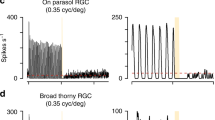Abstract.
Numerous careful behavioral studies of visual persistence have reported a variety of apparently contradictory effects. Variation of flash intensity has particularly been found to have both direct and inverse effects on subjective duration. This conflict has been addressed by theories which contain both sensory and cognitive components. Depending on the weight given to these components, one obtains theories which emphasize intensity dependence or task dependence. Few comparably detailed physiological studies of persistence exist. To clarify the issues raised by these theories, we examined the responses evoked in the model photoreceptor of the Limulus lateral eye. To explore the role of sensory variables, we manipulated adaptation state and flash intensity. To explore cognitive variables, the durations of the photoreceptor potentials (RPs) evoked in this model system were assessed by a mutually complementary and complete set of candidate sensory codes. Accordingly, sharp microelectrodes were used to record RPs intracellularly from single photoreceptor cells in response to 40-ms flashes whose intensity was varied over at least 3.6 log units. Two light adaptation states were used which differed in sensitivity by 3.5 log units. This model system made it possible to employ stringent objective assessments of data quality which ensured that only cells which had remained stable for several hours contributed to the present data. A variety of code-dependent trends were found: direct, inverse, invariant, and U-shaped trends related flash intensity to RP duration, while adaptation state interacted with some of these trends. Only some of the expectations which had generated this research were qualitatively corroborated and numerous quantitative discrepancies were found between data and theory. While caution is necessary when generalizing from neural responses to perception, these data indicate that two major gaps now exist in this field. First, both task and stimulus variables need to be exhaustively explored in more complete behavioral experiments. The present data make it more likely that sensory models and cognitive models simply address different aspects of the same phenomenon. Second, similarly detailed questions need to be posed to more central neural loci, particularly to those in the various visual cortices.
Similar content being viewed by others
Author information
Authors and Affiliations
Additional information
Received: 5 July 2000 / Accepted in revised form: 14 February 2001
Rights and permissions
About this article
Cite this article
Nisly-Nagele, S., Wasserman, G. Dissociating sensory and cognitive contributions to visual persistence I. Photoreceptor response duration as a function of flash intensity, adaptation state, and candidate code. Biol Cybern 85, 167–183 (2001). https://doi.org/10.1007/s004220100251
Issue Date:
DOI: https://doi.org/10.1007/s004220100251




